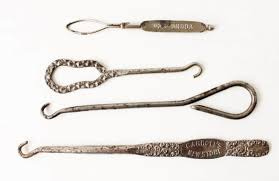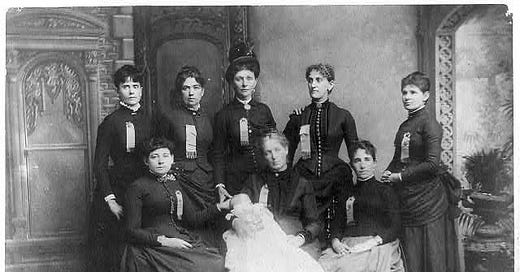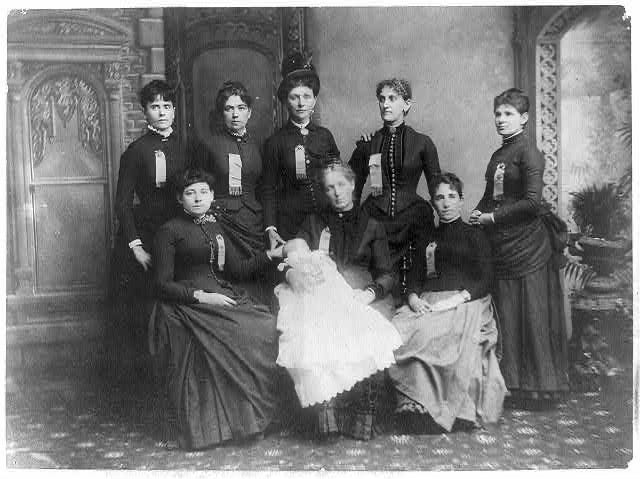From Corsets to Spandex: The Fit for Political Movements
Long skirts, boots, hats, buttons, and corsets were staples in activist ware in 1880s. Did the rigidity of women's garments firm their resolve?
In the late 1800s, women organized under the banner of the Knights of Labor (KoL) to change labor laws and instill protections for workers. In rare solidarity –– rare that is by today’s standards, affluent women joined forces with their sisters in mills to demand better working conditions - including, rooting out sexual harassment.
In the photo, Leonora Kearney Barry, back row center, stands out for both her height and her signature hat, adorned with feathers. Three other women are known, all of whom are forces unto themselves. Holding the baby, Lizzie Rodgers, is Elizabeth Rodgers, a master workman who was also in charge of much of the 50,000 KoL members in Chicago. Elizabeth brought her 12-day old baby - her 10th child to the conference.1 Standing to the right of Elizabeth is Laura Graddick, and seated to the left of the baby is Mary Anderson.2 Mary is 14 or 15 in this photo. A native of Sweden, she was a domestic worker. Eventually, Mary Anderson would hold the office of Director of U.S. Department of Labor for a quarter century.3
These women might be solemn but they are styling. Bustles, corsets, lace collars, broaches, and what seems to be a zillion buttons was the fit of the day for ladies who labored for better labor conditions. The delegates proudly wore the KoL ribbon.
All joking aside, Victorian-era clothing reflected both societal restraints as well as affluence. They were laborious and time-consuming to put on.
Buttons were a result of 19th century industrialization. Suddenly those little things could be made out of any material: glass, metal, shell, bone. Prior to then, brass buttons were reserved for mens clothes, and women had snaps, pins, and hook and eye clasps. And buttons in a buttoned-up society adorned not only dresses (from chin to yolk), but also high-heeled boots.
Button hooks were de rigueur, although affluent women often had live-in help to aide in fastening the dozens of buttons on garments. Restrictive corsets were still the rule despite a growing understanding of associated health risks. And while heavy fabrics prevented them from doing menial labor, it didn’t impede these women from taking on the task of revolutionizing the workplace.

These women, and nearly 50,000 more, organized in 1886 to protest unsanitary, unsafe, and hostile working conditions – and slave wages. In the picture, note the women touching the baby’s head. It’s a symbolic understanding that children are the future and they will have better one.
As the National Investigator for the KoL, Leonora was heckled and harassed by bishops and men for her unladylike stances. Women were supposed to be at home, not in the workplace. The fact that she was widowed with children didn’t seem to earn her an exemption from their scorn. Seems that, like today, strong women scared the hell out of some men.
This picture had me wondering. In the last two weeks, a new administration has imposed executive orders to unravel a century of activism and social progress. At a time when
children are terrified to go to school because armed men (men with arms, sanctioned by the government!) are threatening them - or their friends
labor laws are being repealed so 14-years olds can once again work in meat-packing plants
What will be our response? One hundred years from now, what story will our clothing reveal about us?
In Leonora’s time, heavy skirts and high collars symbolized women’s confinement — but also a pious dedication to a mission. Did the confinement firm their resolve? Today’s penchant for Lululemons and Chucks allows freedom of movement, the question is, does it better enable us to exercise our rights to protest - or enable us to more comfortably run away?
What I am reading
I am 200 pages into Between Friends & Lovers, and enjoying this book by cardiologist, author, and cartoonist, Shirlene Obuobi. Her name came up as one of the top 25 black women to read. It’s a fun romantic novel from a black woman’s perspective, something, I am embarrassed to say, I lack. The protagonist is conflicted by her desire to practice medicine - and feed her soul. Man can I relate. Her characters are terrific. Oh, that we all have a sensitive, yummy, and witty Malcolm in our lives.
Up next: My friend Kristen just sent me the book The Female Brain by another doctor, Louann Brizendine. When do these women have time to have a practice and write full length books???
https://historymatters.gmu.edu/d/91/
https://www.loc.gov/resource/cph.3a14849/










Hi Diane,
I love the history of clothing. So, I enjoyed this post. I was unaware that labor laws are being repealed so 14-year-olds can once again work in meat-packing plants. Any writing that exposes this is good. https://apnews.com/article/illegal-child-labor-slaughterhouses-8f95aef240050c6910aa8e1b6bce1c6a
So many buttons they required special tools. Wow. Lots to unpack from one photograph. I'm curious about the KoL ribbons they wore. I wonder when they wore them. Were they like sashes, intended for public events, or more like nametags worn when they were out organizing in their official capacity. Love her hat!